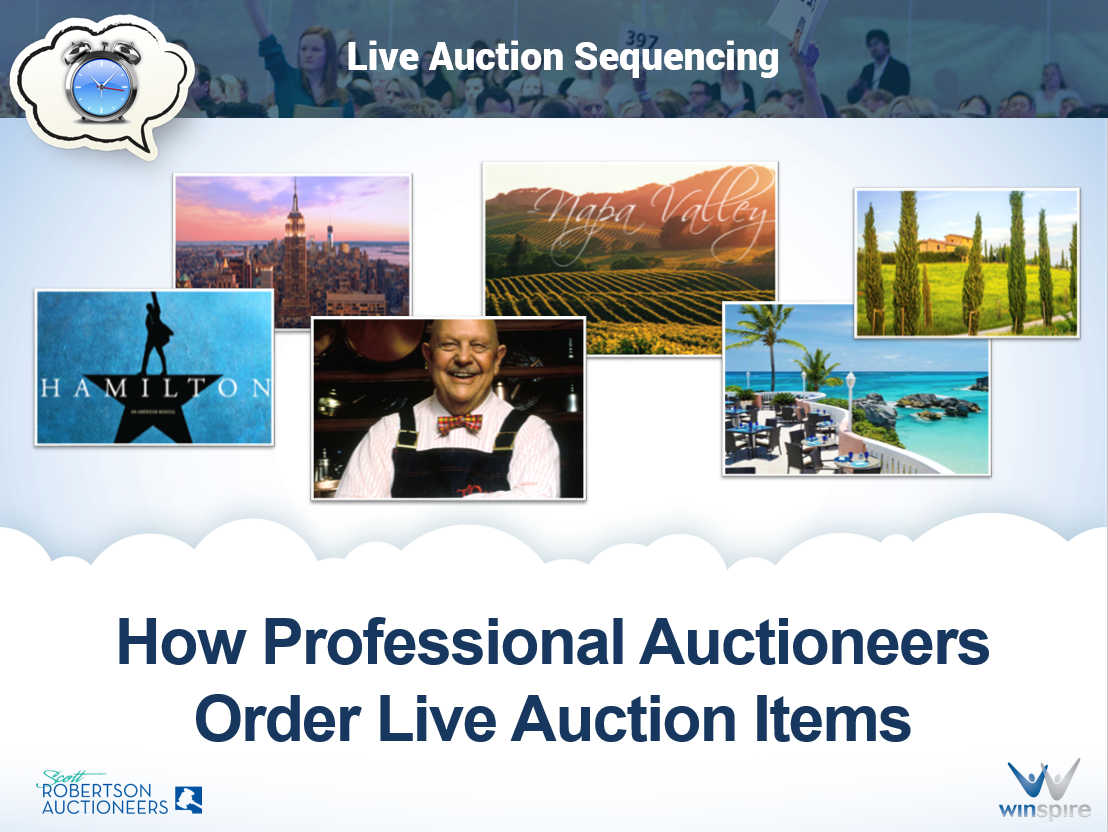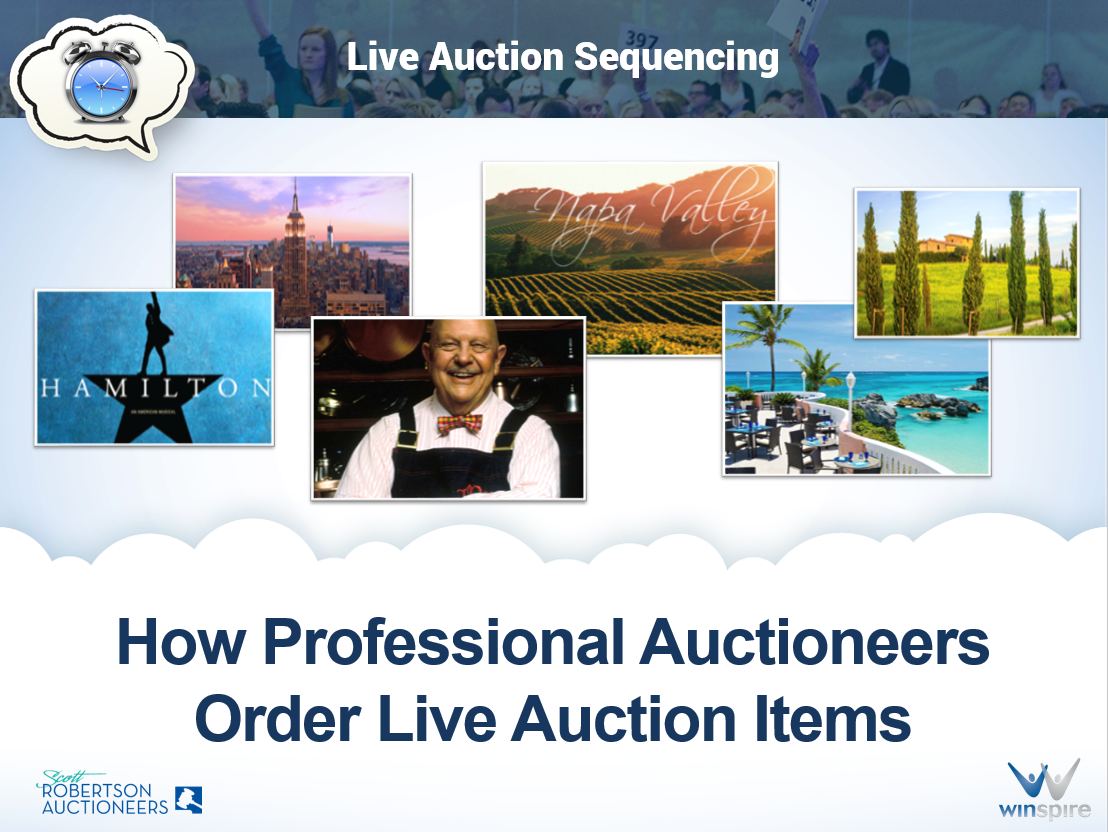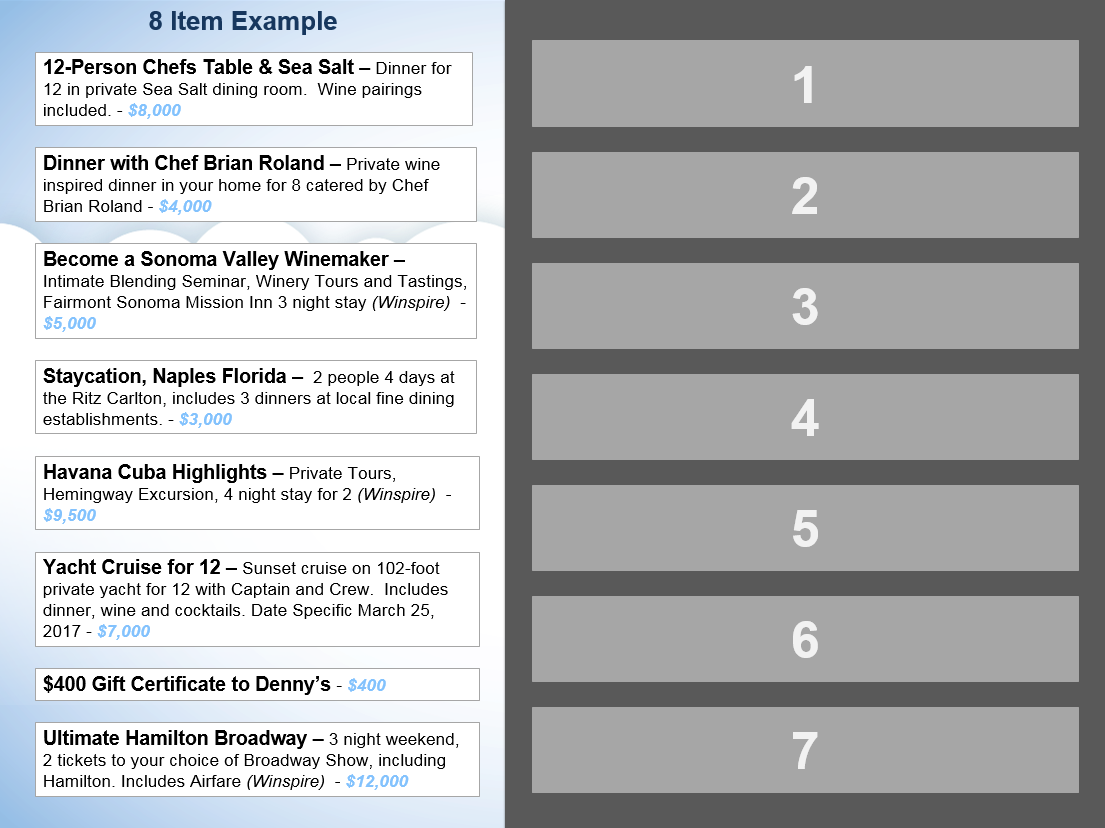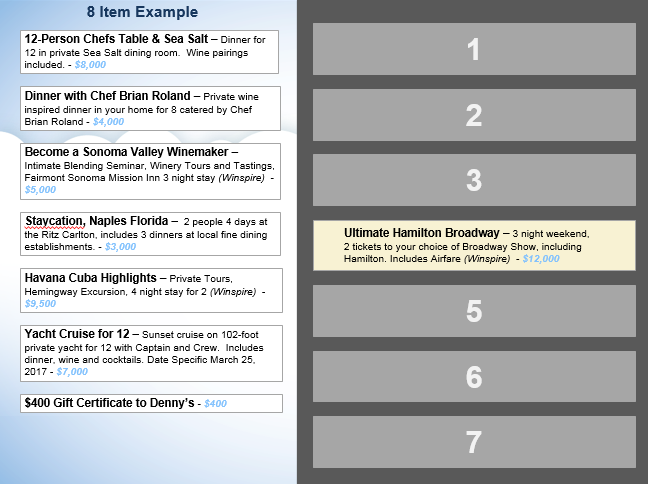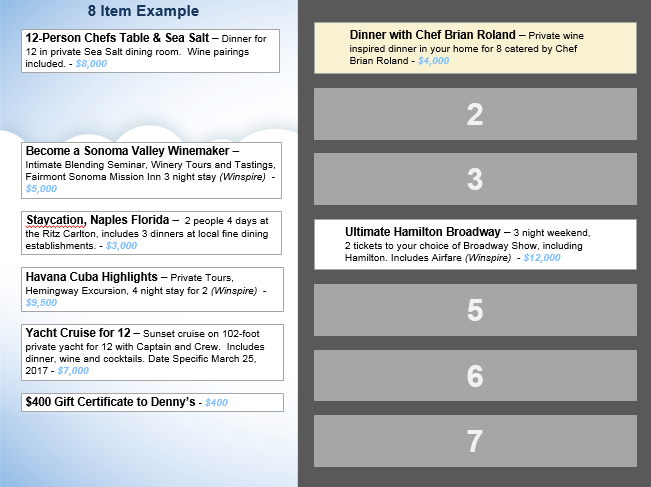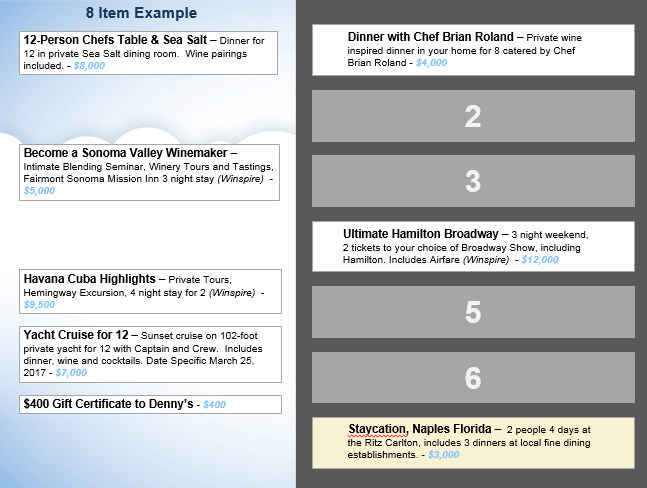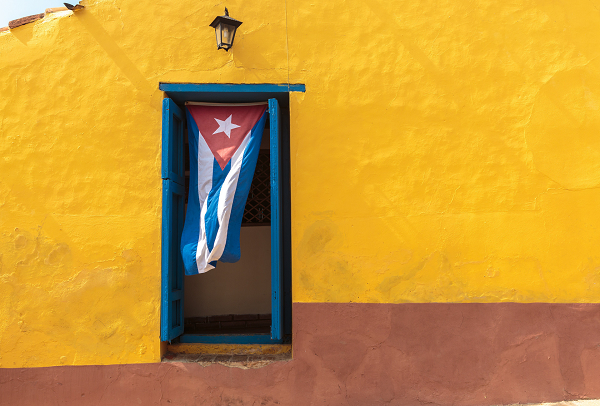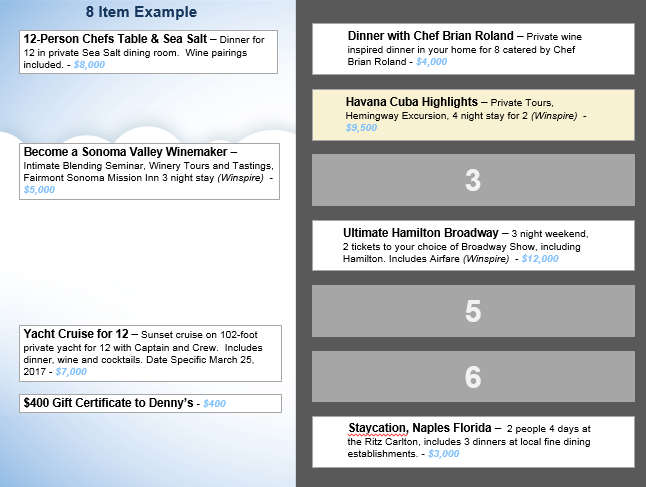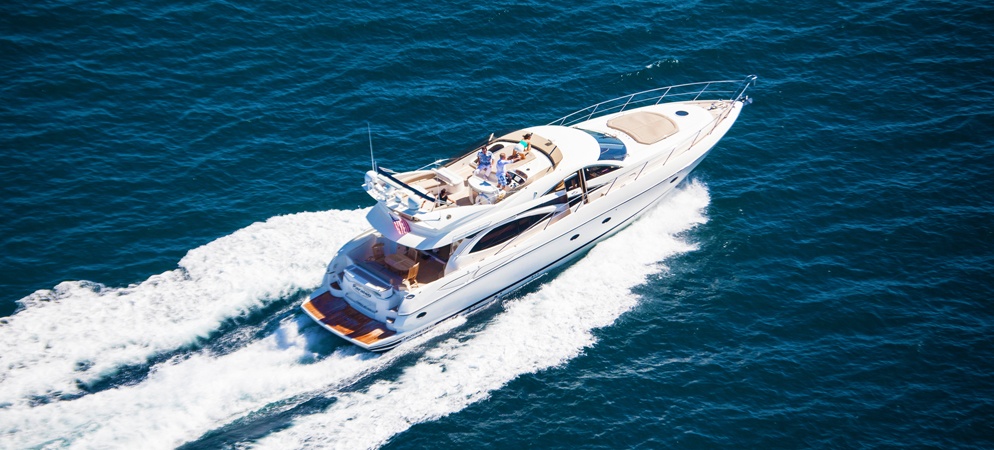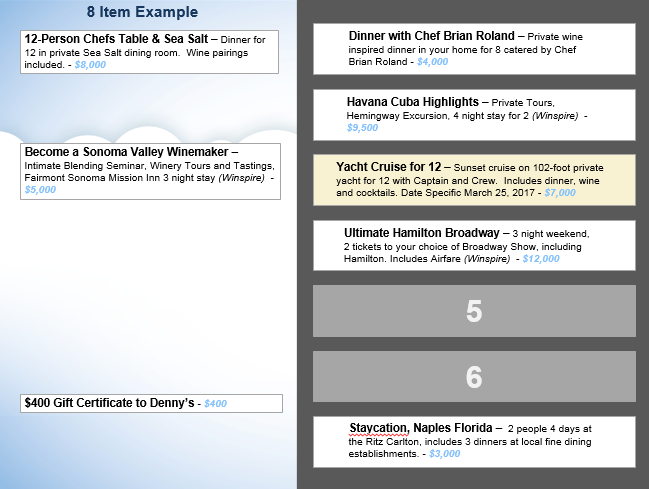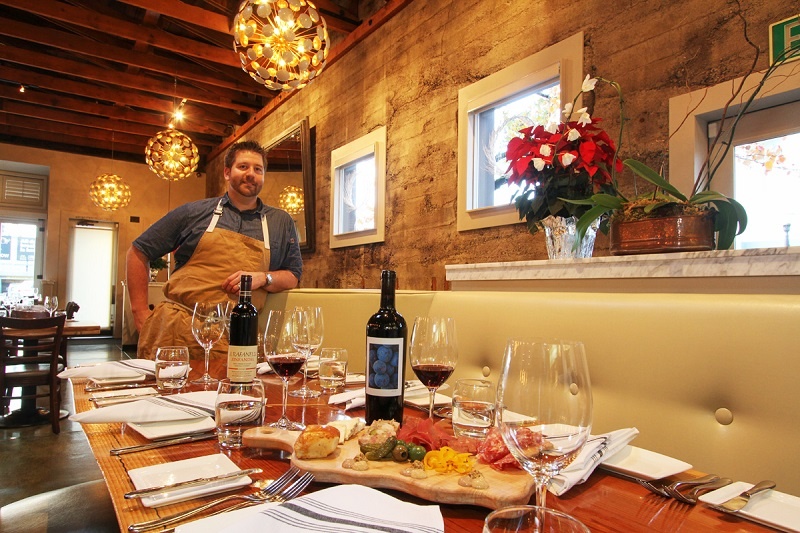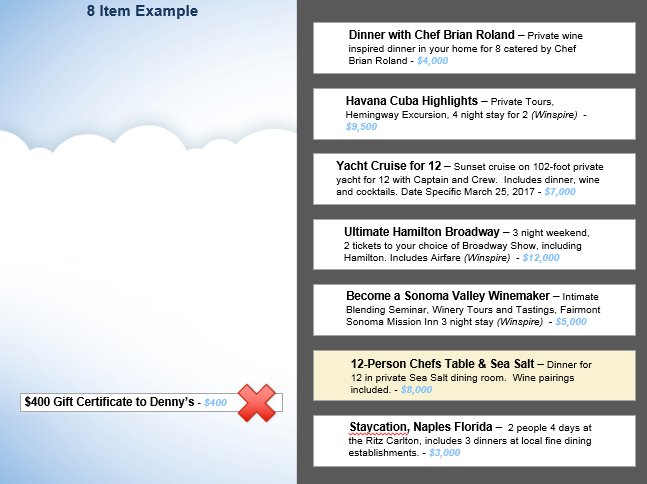When it comes to charity auctions, procuring quality items tends to be auction organizers’ biggest challenge. Once you do wrangle those big-ticket items, are you all set? Not so fast – it’s now time to consider the order in which they’re presented.
“This idea gets glazed over a lot, and people don’t really think about it too much, but it’s actually very crucial,” asserts benefit auctioneer Scott Robertson.
In today’s post, check out 8 sample live auction items. Can you guess the expert-suggested order to capture the highest bids possible?
General Tips
Before we look at the list of items, here are a couple basic guidelines that ring true for the majority of live auction events.
Include 7 to 12 items in the live auction. The exact number depends on how much time you are devoting to the live auction; the size of your audience; and the amount you’re trying to raise. In general, 7 to 12 items is sufficient. For more, see…
{{cta(‘eee0bd1e-ee7f-449f-822b-08d8fdab4f35′,’justifycenter’)}}
Get help from a professional fundraising auctioneer. “If we don’t pay for ourselves, we don’t deserve the job,” asserts benefit auctioneer Scott Robertson in a recent webinar. One of the biggest perks of hiring a professional benefit auctioneer, besides the actual selling of the items, is that they can help put auction items in an order that makes sense and earns the highest bids.
“An auctioneer will understand the flow of the room, and how energy ebbs and flows,” Robertson says. “They’re thinking about how they’re going to sell, and how one item sets up another.” So take advantage of that expertise.
Ordering Your Items
Now that we’ve established some ground rules, let’s look at the specific example. Here are the items and bids we’re expecting to get. What would you do with these 8 items?
Step 1: Start with the highlight of the live auction
(A note on the process: “To determine an auction sequence, first I print and cut out descriptions of all the items, then I lay them out on a table so I can rearrange them,” Robertson says.)
When figuring out the live auction sequence, Robertson doesn’t start with Item #1, and here’s why.
“What I do first is pick the item that I think is going to be the most popular and is going to be the best item,” he explains. That’s because your auction is a “bell curve” of energy. “You want to place your most valuable item just past halfway of the auction – in this case, spot 4 or 5.”
As you consider the items, Hamilton may catch your eye. “There’s two kinds of people in the world: Those that have seen Hamilton, and those who want to go see it – and maybe those who want to go again,” Robertson quips. With the Winspire Hamilton Experience, not only do your donors receive tickets, they can meet two members of the cast, get a private backstage tour and more.
“I don’t think there’s any limit to how many times you can see this. So let’s go ahead and move Hamilton to that coveted middle spot.”
Step 2: Determine the first item
“Now the next thing I want to do is I want to figure out which one I want to go first,” Robertson says.
What you do right out of the gate is important, because it sets up the energy levels and bidding expectations for the rest of the auction. There’s generally two schools of thought on how to kick off the live auction with a bang.
Option 1: Break the ice
Benefit auctioneer Danny Hooper grabs everyone’s attention with an “icebreaker item”: think donated flat-screen TV, case of wine or electronic gadget.
He kicks off bidding at an exorbitant price, say, $10,000. Of course, nobody will raise a hand. Bidding is then lowered to $5,000, then $2,500, then $1,000, and finally jumps down to $20. “Come on folks, how about $20? Would anybody give me $20 for this flat-screen TV?” And as soon as a hand goes up, the item is declared sold for $20.
Talk about starting your auction off on a high note! An icebreaker gets the crowd’s attention and shows how easy it is to participate in the auction. The activity is also wildly entertaining—one of three basic tenants of a successful fundraising event.
{{cta(’80f85376-39d1-40aa-ae2a-bc4be194d7e3′)}}
Option 2: Set the bar high
“I don’t start with a warm-up item – I gave up on those ten years ago,” Robertson counters. “I start with an item with wide appeal, like box seats in the suite of your favorite sports team. Everyone may not be willing to pay for it, but they’d love to own it, therefore we’ve captured everyone’s attention. Now the only question is, how much would they pay? “
This item is also typically in the middle of the range your item values. This establishes the caliber of spending expected in the auction: No one’s going to get away with a “bargain” at this fundraiser. You want to keep the messaging laser-focused on your cause, and that starts with the very first item on the auction block.
For the purposes of this post, we’ll go with Option 2. Which of these items has wide appeal and sits near the middle of estimated values?
“That first item for me is the dinner with Chef Brian Roland, a celebrity chef based in Naples, Fla. Everybody loves Chef Roland, and I need to start with something that everyone in the room would love to have. So let’s put him in the first position,” Robertson says.
Step 3. Determine the last item.
The next thing you want to do is figure out which item you want to go last. You don’t want to sell a dud, but you also don’t want to end with the best item.
Fact is, people can walk out or stop paying attention – or hold onto their money throughout the auction only to walk out of the room suddenly without having given anything.
“What I’m going to do is put the seven-night staycation last, which is going to keep everybody’s attention through the auction,” Robertson advises. Staycations are typically easier to get donated, because airfare is not needed. They’re also popular with organizations like schools, because families don’t have to worry about their kids, flying, and all the issues associated with a longer trip.
“Also, if you’re going to have something that’s really going to create a lot of commotion and make a show in the room, like celebrity firefighters, you’d want to put them last too,” Robertson says. This ensures the auction ends on an exciting high note.
Step 4. Fill in the rest of the items.
For the remaining few items, let’s start with spot #2. The auction began with a private wine-inspired dinner. To follow it up, travel packages are always top sellers at charity auctions, but Havana in particular has amazing cuisine.
“Havana, Cuba – my goodness, what a hot package,” Robertson says. “I just got back from Cuba, and I can tell you everybody needs to go. It’s absolutely wonderful, it’s fun, and the food is great. It’s an eye opener to go see Cuba, which is just 90 miles off the coast of Florida. So I’m going to move Havana, Cuba up to the number two spot.”
Step 5. Separate similar items.
If you have similar items – dinners, international trips, etc. – spread them out. Then sell the better package first and the weaker second.
Why? Bidders interested in similar packages will always go for the better one. Then the bidder who doesn’t win the first item can go for the second – or purchase a multiple sale that matches the high bidder price.
{{cta(‘2a6779a6-bbb4-43fe-a53c-ad87f4954809’)}}
Check out this principle in action as we determine the remaining spots.
One one hand you’ve got a yacht cruise on a 102-foot yacht for 12. It’s date-specific and includes dinner, wine and cocktails. On the other hand, you’ve got a 12-person dinner at Sea Salt. Which group dinner should come first?
“I believe the yacht cruise is going to be more popular. Even though it’s not valued as high, I think it’s going to be seen as more unique and exclusive,” Robertson says. “So I’m going to move the yacht cruise into the 3 position.”
Now you’ll want to move the chef’s table into the sixth spot, and here’s the reason:
“You had multiple groups of bidders get together to pool their money and bid on the yacht cruise, but there was only one winner. Now those other six couples have a chance to spend that money and go to the chef’s table at Sea Salt.
“You wouldn’t put the dinner directly below the cruise, because the group needs time to agree amongst themselves and get their bidding people together. So you can move it one spot lower, to number 6.”
Now all that remains for spot number 5 is the Sonoma trip. “Everybody loves wine country. This package, Sonoma Wine & Dine, is a Winspire package, and it’s part of the reason why I’m here. They do a great job,” Robertson says.
If your donors like wine, this package comes with a private wine tasting with acclaimed winemaker Jesse Katz, plus a 5-hour tasting menu at Valette Restaurant in Healdsburg (pictured above), deluxe accommodations and more.
The final results:
Step 6. Relocate the duds.
Did you notice one of these items was not like the other? Yep, we’re looking at you, $400 gift certificate to Denny’s. This is still a valuable donation, but simply doesn’t fit in with the caliber of other items offered.
“If you’re going to sell a $10,000 item, don’t sell an item for $400 at the same time. You can see the prices we’re hoping to get for the other items, so you don’t want people thinking other items will go for $400 too. Instead, take that gift certificate and put it in the silent.”
So there you have it: our suggested order. We hope these tips gave some insight into how to the pros arrange auction items. Be sure to work with your fundraising auctioneer, who can help determine the best sequence for your needs.
{{cta(‘222323c1-4c45-44f5-92d9-92afd8782c22′,’justifycenter’)}}
Your turn – how would you order these items? What sequence tips have you seen work like magic in live auctions? Let us know in the comments below!
